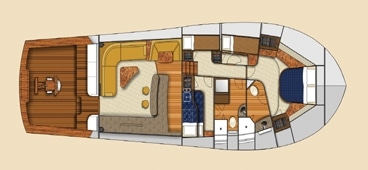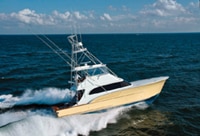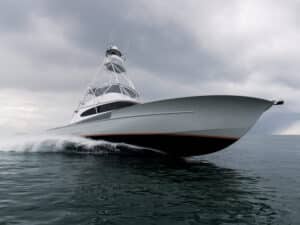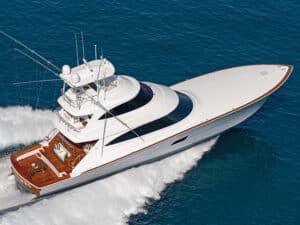
Scully Layout
“Our Ride, Your Vision” is Sculley’s corporate philosophy, and it must work since the company has enough boats under contract to keep it busy for the next several years with no slowdown in sight. Though Sculley is building all bigger boats, its success rests on its ability to build fast, high-quality, seaworthy vessels that make use of virtually every square inch of dead space aboard while incorporating truly unique and noteworthy design features.
Performance

Not even a week after Hurricane Wilma devastated Fort Lauderdale, we headed out of Port Everglades into a growing northeasterly sea with 15- to 20-knot winds. The Sculley 60 drove straight into the 4-foot head sea without pounding and without a single drop of spray on the flybridge enclosure – a great testament to the design skills of Steve French at Applied Concepts and Jim Polatty, Sculley’s chief engineer. We cruised down-sea at 35 knots, tracking perfectly straight with hands off the wheel, and the spray never rose higher than the rail. I also loved the control with the tabs; being able to lift the upwind side to smooth the beam-sea ride even more made for a pleasurable cruise.
The 60 spins on a fish quite adequately, though not as fast as a boat half its size would. It backs down arrow straight at 6 knots before the seas top the cap rail; however, the cockpit drains instantly.
This boat turns superbly. I relished the ability to get her around running at almost 40 knots within less than three boat lengths, using only a single finger on the power-assisted steering wheel.
Flybridge

The Sculley 60’s flybridge offers absolutely everything a good skipper could want – and then some. An expansive electronics compartment rises on rams, but when closed it makes a superb hors d’oeuvres and cocktail table for the flybridge lounge. An unusual curved helm console represents one of the most appealing facets of Sculley’s overall design: You’ll find very few straight lines aboard these boats. Radius curves rule.
Forward seating forms a J, wrapping around the entire forward area, then stretching back to the ladder, where a closable hatch protects flybridge passengers from unexpected descents into the cockpit. You’ll find rod storage both overhead and under the flybridge settees, while a hatch over the helm seat hides the teaser reels.
Sculley provides tons of storage everywhere, thanks to its awesome use of dead space. If you actually filled every storage spot aboard this 60, you might be faced with repainting the boot stripe an inch or two higher!
This model sports a 3-inch step at the helm. The owner requested that the helm be placed a foot farther aft than the spot Sculley usually places it so he could see clearly over the bow. Of course, the aft placement of the helm also means the view of the cockpit could hardly be better.
Engine Room
Spelunkers should particularly appreciate the engine room. I had misgivings squeezing my bulk through a tight entryway to the engine compartment. But once you’re through, the area opens up into a cavernous space with room to move both in board and outboard of the engines. Although Sculley placed the generator on the forward bulkhead, it abuts the stairs to belowdecks in the living quarters rather than a cabin. As befits a true offshore boat, there’s a crash pump with a Y-valve affixed to each engine.
Here, too, Sculley provides loads of storage, including overhead cabinetry along the aft bulkhead. Every surface gleams with a nonporous, easy-to-clean Awlgrip finish.
Interior

I think I can safely say that you won’t find another boat this size with more rod and tackle storage. The seven rocket launchers and other storage on the flybridge represent only the start. Rod lockers under the settees in the salon combine with a dedicated rod locker in the day-berth area to provide enough space for six rods of virtually every saltwater weight class. An etched-glass panel showcases rods in the bulkhead.
Sculley utilizes another variation on a standard theme belowdecks. The day-berth area that sports a pair of single berths actually makes up the main tackle storage space as well. Each berth lifts to reveal multilayer lure, line and leader storage compartments. Adjoining lockers contain still more tackle storage. In all, its one of the most ingenious storage systems I’ve ever seen. This section alone is worth the price of admission.
Water Witch won’t be making long-range trips. Rather, the owner plans to take groups of people out for a weekend of offshore fishing. The living quarters reflect that application, with most cabins sporting over/under single berths (each with its own TV screen and headphones). The only double is the master cabin in the forepeak with a queen-size island berth. (Even the berths have radius edges.)
You’ll find storage under each single berth, and hanging lockers get two tiers to accommodate two guests’ belongings. In fact, every deep storage compartment aboard Water Witch comprises at least two levels, and in some cases more.
Instead of providing a day head, Sculley offers two heads below, both large enough to allow room to actually dry off in the head after a shower rather than needing to move back into your cabin as is the case on many boats.
Up on the main deck level, Sculley installs huge windows in the salon, creating an incredibly light and airy ambience. The salon layout – relatively traditional with a twist – finds an L-shaped settee (with integral storage) to port and a shallow banquette dinette just forward. The starboard side holds the entertainment center, replete with a hidden big-screen plasma TV on rams, and the galley/lunch counter on the forward end. Counters consist of a new Corianlike product called Caradon with wood edge inlays. The galley counter contains a KitchenAid ceramic cooktop with flush ceramic controls.
Electronics play a big role on the Water Witch. Each stateroom, the flybridge and the salon all offer “on-demand” music, TV and movies with independent selection and control. Each display also provides personal headphones. Finally, a pneumatic door leads out to the cockpit.
Cockpit

The first thing I noticed was the beautiful teak coaming, rounded to comfort your thighs when fighting a fish. I’ll take this one over coaming pads any day. And of course no self-respecting sportfishing convertible today gets by without the obligatory cockpit mezzanine. Everyone sets them up differently, and Sculley accommodates personal taste by customizing it any way you wish. On Water Witch, the starboard side of the salon door houses the repositories for ice from the Eskimo ice maker. A large, refrigerated drink box rests under the salon step, abutted by the engine-room access on centerline. Outboard to port, Water Witch carries several deep freezes for bait and food. And of course seating stretches the full width atop the mezzanine.
Sculley lines all the mezzanine boxes, along with the in-deck and transom fish boxes, with stainless steel, the floors of which slope down toward centerline, assuring that water and detritus will drain toward the large hole in the bottom. I also liked the retractable washdown hoses under the gunwale in the cockpit as well as on the foredeck.
Design and Construction
Sculley – like most custom-sportfisherman builders today – cold-molds its boats. This results in a very strong, lightweight hull. You can expect only the finest ingredients such as epoxy, rather than polyester resins, and Okoume plywood, rather than some cheaper, non-marine-oriented variety.
As stated earlier, every hidden surface throughout the boat sports a glossy Awlgrip finish for easy maintenance. Stick your head up inside a locker – somewhere you probably were never meant to look – and you’ll find a finished surface. Sculley pays attention to every last detail aboard its boats so you don’t have to.
Specifications
LOA 60′
BEAM 18’3″
DRAFT 5’2″
WEIGHT 65,000 pounds
FUEL 1,500 gallons
WATER 250 gallons
MAX POWER T 1,550-hp
Cat C-30s
BASE PRICE $3,000,000 (as tested)
Sculley Boatbuilders
Wanchese, North Carolina
252-473-6855
www.sculleyboatbuilders.com







